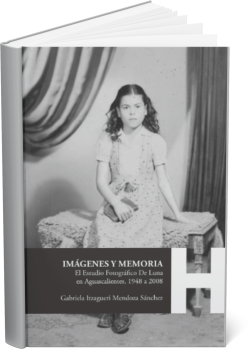IMAGES AND MEMORY: De Luna Photographic Studio in Aguascalientes, 1948 to 2008
Synopsis
This research has aimed to analyze the portraits made by three generations of photographers in their work concentrated in the De Luna Photographic Studio in Aguascalientes, with an archive that includes the negatives of their production from 1948 to 2008, which has allowed this work to identify those forms that remained, as well as those that were transformed into images, understanding that there is a complex relationship with the social and cultural world that makes them possible. Given the difficulty of historicizing photographic materials, even more so when dealing with the most commonly carried out portraits, and paradoxically less studied, it was necessary to propose, also as an exercise proper to sociocultural studies, the theoretical-methodological approach for the analysis.
Thanks to the historiographical study necessary for any research that wishes to participate in the historical perspective, it became possible to approach the study with the history of the image, based on the works of Hans Belting, who brings together history with anthropology, and Georges Didi-Huberman, both contemporary historians of the image, where the latter recovers the approaches of authors who were able to recognize the centrality of images for history and who propose to build methodologies that are both more open and complex, compared to other traditions more identified as art history, within which the images selected for this history have not had a place.
Although the approaches from studies that focus on the image could be sufficient for research that observes an image or a sequence of images, the need arose to have certain variations in the approach from which they come; Likewise, authors who have synthesized and tried to respond to discussions within history and the social sciences for history that, although not specific to the study of visual images, provided fundamental tools, such as Italian microhistory, new cultural history and social history, using concepts linked to the study of childhood, family and gender within the analysis of portraits. The exercise of analyzing these variations and bringing them together for the methodology, while allowing the examination of photographic materials, gives the opportunity to present this research as a theoretical-methodological proposal from sociocultural studies for the history of the image.
The set of photographs contains a richness that questions the disdain that, at times, could be presented towards this type of portraits, perhaps because, paradoxically, the fact that each one of us owns at least one could lead to considering them common and without any other value than nostalgia. It is hoped, then, that this work dedicated to memory and images will awaken some enthusiasm in various readers, to stop and see that with each gesture, however small, we take part in the perceptions, in the interpretations of the world, and with them, in effect, the alteration of its forms is made possible.

Downloads
Published
Series
Categories
License

This work is licensed under a Creative Commons Attribution-ShareAlike 4.0 International License.













